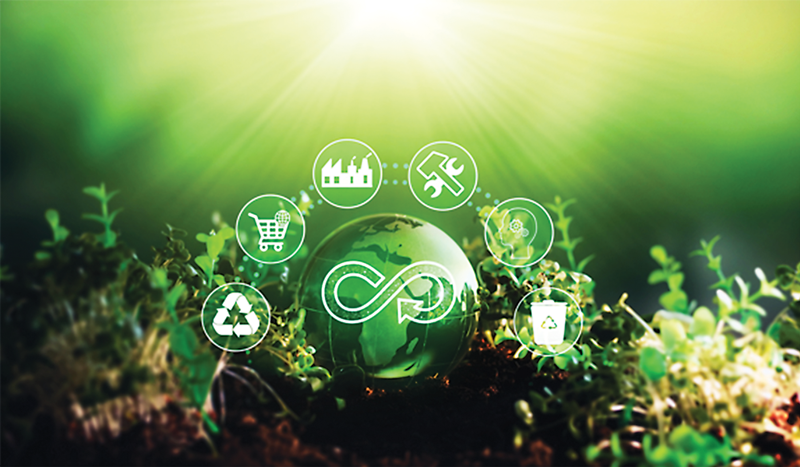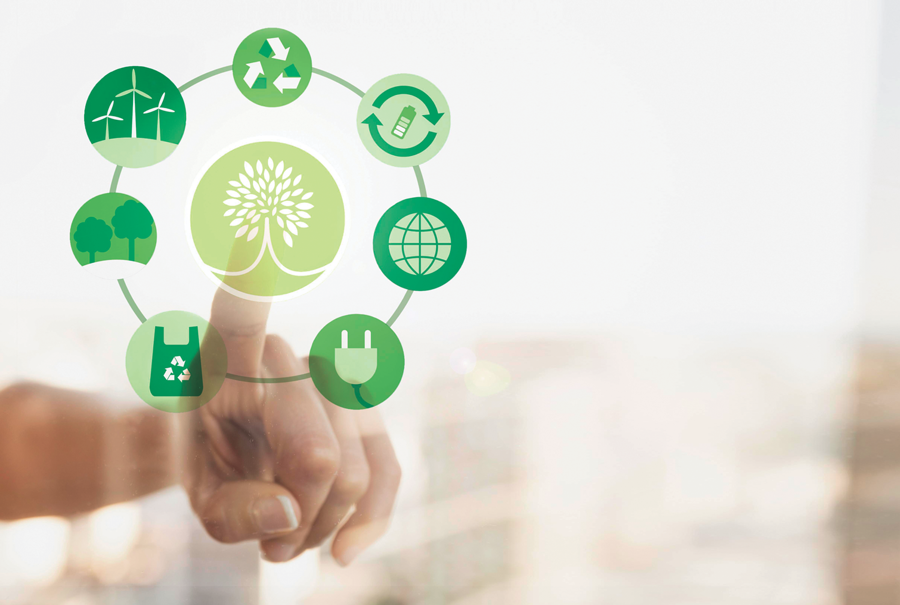Implementing a circular economy is a key solution to innovate the growth model, improve quality, efficiency, competitiveness, improve labor productivity, and create new, effective value-added chains. high efficiency, harmonizing the relationship between the economy and environmental protection, contributing to implementing commitments on nature conservation, biodiversity, carbon neutrality and net zero emissions by 2050…

Circular economy is an economic development approach that replaces the previous linear economic approach. Since 2020, the concept of Circular Economy has been specifically regulated by the Government of Vietnam in the Law on Environmental Protection 2020. Decree 08/2022/ND-CP, the Ministry of Natural Resources and Environment is assigned to preside, Coordinate with ministries, ministerial-level agencies, and Provincial People’s Committees to develop and collect comments to complete the draft National Action Plan to implement circular economy until 2030 and submit to the Prime Minister for promulgation. This plan is due to be submitted before December 31, 2023.
CIRCULAR ECONOMY TREND
According to experts, promoting the application of circular economy is a strong trend in many countries around the world. This initiative is receiving strong response from the business community and organizations.
Preliminary statistics in the world show that up to now, it is estimated that more than 30 countries and territories have been and are expected to build roadmaps to implement circular economy under different names such as: plans, strategies, and roadmaps such as the 2nd Circular Economy Action Plan of the European Union issued for the second time, accompanied by a monitoring framework and circular economy indicators to provide general direction for the entire bloc. .
In particular, in 2021, the ASEAN Commission issued the Circular Economic Framework for the ASEAN Economic Community. The Circular Economy Framework sets out a long-term vision with circular economy ambitions that build on existing initiatives and identifies priority focus areas for action to accelerate progress towards realizing a circular economy in the future. ASEAN.
Vietnam is one of the first countries in the ASEAN region to incorporate circular economy into the Environmental Protection Law and its guiding documents.
At the consultation workshop on the outline of the national action plan and key areas in implementing circular economy that took place earlier, Dr. Nguyen Dinh Tho, Director of the Institute of Strategy and Policy on Natural Resources and Environment, said Article 142 of the Law on Environmental Protection provides regulations on circular economy. Decree No. 08/2022/ND-CP detailing several articles of the Law on Environmental Protection, providing detailed instructions on criteria, methods of application, assignment of responsibilities and mechanisms to encourage the application of weekly economy complete.
In addition, many important policy tools that play the role of adjusting the behavior of producers and consumers in the economy in an environmentally friendly way will contribute to promoting the comprehensive implementation of a circular economy. , effectiveness and efficiency.
According to experts, the early recognition and institutionalization of the concept and regulations of circular economy into the policy and legal system has received strong support from the international community and consensus among the world. scientifically and there have been signs of support and response with specific actions from the business community towards this potential economic model.
Circular economy is considered an effective solution to solve global challenges such as climate change, biodiversity loss, waste pollution, and promote sustainable development measures.
BUILDING A PLAN FOR REALIZING THE CIRCULAR ECONOMY
The draft Decision of the Prime Minister promulgating the National Action Plan to implement a circular economy by 2030, which is being consulted for completion, also emphasizes the goal of forming a sustainable production and consumption structure system, effectively use the value of natural resources, raw materials, and used materials, minimize waste into the environment, promote the regeneration of nature on the basis of choosing and applying business models. circulatory system is popular and suitable.
Effectively exploit the innovation and creativity potential of the business community and people to promote the application of circular economy, associated with good practices, creating culture in production, business and consumption, moving towards forming a material circular society.
The draft plan sets a goal that by 2025, it will build and establish a mechanism to operate an information connection and data sharing platform to implement a circular economy. Issue a guiding framework; Complete the development and promulgation of action plans to implement circular economy for sectors, fields and localities.

Circular economy will be integrated into development strategies, plans, plans, programs and projects; manage, reuse and recycle waste at all levels and sectors. Along with that, promulgate and organize guidance on effective application of regulations, standards, and technical regulations on promoting the implementation of circular economy in environmental protection laws and other relevant laws.
The plan also sets the goal of developing documents and organizing guidance on applying circular economy to a number of priority industries and fields according to the roadmap; Establish a system of organization, management, monitoring, evaluation, support and build a general monitoring framework for implementing circular economy.
By 2030, the draft plan sets the goal of circular economy being disseminated, widely applied and is a priority principle and approach in management, production, business, consumption and waste management. at all levels, industries, fields, and economic sectors. Form an institutional environment, policy system, law, science, technology and technical infrastructure that is synchronous, practical and effective to promote innovation and creativity in applying circular economy towards Modern based on digital technology.
Develop good habits and practices in applying circular economy to production, business and consumption; popularize and replicate circular economy models suitable to the advantages and characteristics of each industry, field and locality.
According to the draft, Vietnam also aims to form supply chains and recover raw materials and fuel according to key products and waste streams according to the strategies, measures and criteria of the circular economy. with some products having great potential or consuming a lot of raw materials, materials and energy.
Strive to achieve targets on efficient use of resources, reuse and recycling of waste equivalent to leading countries in ASEAN; make a significant contribution to the goal of green recovery in production, business and consumption sectors.
The draft plan emphasizes the view that implementing circular economy is an interdisciplinary task and the responsibility of the entire society with the participation of all levels of government, ministries, branches, localities, organizations and individuals. The State plays the role of creating and perfecting institutions, policies, laws, mechanisms, directions, providing information and data, creating space, motivation and conditions for the process of transformation and application. circular economic model; The rights and interests of consumers, businesses, cooperatives, communities, organizations and individuals are the driving force behind the implementation of circular economy.
5 TOPICS OF IMPLEMENTING CIRCULAR ECONOMY
Implementing a circular economy is a long and continuous process that needs to be evaluated and adjusted on the basis of ensuring continuity throughout the implementation process. Make the most of the advantages, potentials and characteristics of industries, fields, regions and localities to select, research, pilot, replicate and develop appropriate circular economy models , effective, competitive…
The Draft Plan identifies 5 topics for implementing circular economy with 17 groups of tasks and activities and 56 specific tasks and activities.
Accordingly, 5 main topics are proposed including: (i) raising awareness, knowledge, skills and developing good practices on implementing circular economy; (ii) build and perfect institutions and policies, improve the effectiveness and efficiency of state management in implementing circular economy; (iii) support to promote the application of circular economy in production, business and consumption; (iv) waste management to implement circular economy; (v) strengthen linkages, cooperation, monitoring and evaluation of circular economy implementation…
















